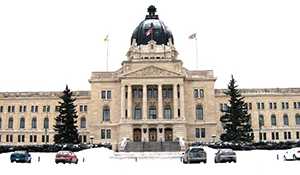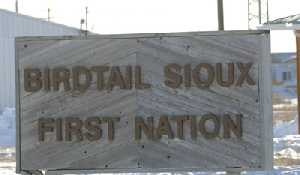Warmer winter temps expected
December 16, 2014, 8:07 am
Julia Dima


After a colder than expected winter last year, the Prairies may be in for a bit of a break this year, according to Environment Canada’s senior climatologist, David Phillips.
Last winter, the outlook called for a colder winter, but not as cold as it turned out to be. This winter, both Pacific air from the west and Arctic air from the north will impact temperatures across the Prairies.
“We think that because El Niño is present, there was a warm pool of water in the Pacific—now it’s weaker—but what it’s going to do is the weather charts are going to be shared equally with an El Niño and a polar vortex. So, we’re going to have a little bit of weather wars out there—the cold Arctic air that dominated last year won’t dominate as much this year,” Phillips says.
“We think that the equal play will be Pacific and Arctic air, where, at times . . . you’ll clearly know where the air is coming from, and times where it is moderating between the two (the air will mix), so even when you do get that Arctic air, it won’t seem as cold, and the Pacific air won’t feel like Vancouver because of the presence of the Arctic air.”
Colder than average temperatures throughout November worried people that like last year, the early cold temperatures would set the tone for the season, but Phillips says the outlook suggests otherwise.
“November started off cold last year and it sort of set the scene. And this year, being a little colder, there’s a lot of worry, I sense, that people think ‘we’re going to be in for another tough winter,’” he says.
“Look at (last) week—we started off with a high of -13 in Moosomin, that’s fairly cold. But by the end of the week, it was plus five with sunshine—I think this is the flavor of what we’re going to see this winter. We will have incursions of Pacific air that will be melting, and then we’ll have outbreaks of Arctic air that will be freezing, and that is the kind of pattern we think will be established.
“Now, there will be moments you’ll wish you were somewhere else—it’s just always the case, we cannot escape winter—but we think there will be more moderation in it. There won’t be those long bouts of weeks to months with brutally cold temperatures and face-numbing wind chills. We think it will be more like a week or two of this, and a week or two of that. So, it will make winter seem shorter. When the weather stays the same week after week, then it gets kind of boring, the season feels slower, and we feel sorry for ourselves. Where you get a little bit of a back and forth and the weather is changing, the season gallops along, so we think at the end of it that winter doesn’t seem as long.”
At any rate, Phillips says, people in the Prairies can expect a break from the solid block of cold weather seen last year.
“Even without El Niño, my sense is that nature doesn’t generally produce two back-to-back hard years. It’s hard to imagine this year being tougher than it was last year. It was a bit of an aberration. I think, saying it’s not going to be as long and tough as last year is pretty easy to say,” Phillips says.
One downside of warmer temperatures and Pacific air is an increased amount of snowfall this winter, though Phillips says snowfall is impossible to predict with any certainty for the season.
With more snowfall comes more worry about a heavy spring melt that could cause flooding, especially with the oversaturated ground from summer floods. Phillips says if temperatures fluctuate between very warm and very cold as they should with the El Niño and polar vortex competing, that should help reduce spring flooding.
“Having the weather more lukewarm, having it more up-and-down with a little more variation—from a temperature point of view—it tends to ease you into spring with a lack of a flood situation. Because it sort of evaporates and melts throughout the winter season, it kind of cushions the blow,” he says.
The fluctuation between cold and warm temperatures throughout the season has positive impacts, but it could also have negative impacts for winter activities that rely on colder temperatures—like skating and skiing. Warm temperatures and bright sunlight was causing some melt last week, but Moosomin recreation director Mike Schwean says it would have to stay in the plus five to 10 range for many days in order to start melting Moosomin’s outdoor rink.
“Even if it is above zero, when it cools off at night it freezes up again. In the spring, there’s a different warmth in the sun, so it melts, but this time of year, it would have to get pretty warm to melt the ice,” he says. “I mean, it’s possible . . . we’ve had it where it almost wants to start melting, and that actually makes the ice nicer—it gets a fine melt, and then freezes back over perfectly smooth.”
Schwean says that the outdoor rink used to have melting issues in February when the sun got warmer, and reflected off of the plywood boards.
“We couldn’t figure out why it was melting in February at minus five, and saw it was melting exactly where the plywood was reflecting on the ice,” he says, “but we painted the plywood white, and now it just absorbs the light, it doesn’t reflect it back onto the ice and melt.”
Schwean adds that since the ice came in on the rink, it has been busy.
On the ski hills, the warm weather does impact slope conditions throughout the season, but at Assessipi Ski Resort, the warm weather last week had perfect timing, with the warm weather hitting just in time for their opening day last Friday.
“We had a great season for snow-making because it was so cold, so for us, it’s the perfect scenario—where, prior to the season, it is cold for a couple of weeks, and we have lots of time to make some good nice crisp snow, and have it warm up for that opening weekend,” says Roz Pulo, with Assesippi Ski Resort.
Snow-making requires temperatures below minus 10, so a colder than average November was ideal for the resort.
“How it works is we pump up water from the river, and it goes through these picks that break up the water droplets into tiny particles and shoot them into the air, that turns into snow by the time it hits the ground. So, you do need cold. When the temperature is cold and dry, that’s the best time to make snow. We look for minus 10 typically to do that, and our snow crew is on call 24/7 and as soon as the temperatures drop, they are working—that’s right from the beginning of November until the snow is done,” Pulo says.
She adds that if temperatures were as warm as last week’s leading up to opening day, they would not be able to make snow and opening day may have been delayed. Warmer temperatures right now will not be enough to melt the snow to the point that runs can’t be used.
“Because they’ve been making snow for so long, they go for a good two to three foot base. And all of our runs do face the north, so nothing gets direct sunlight. If you have a lot of snow in the shade, it would have to be over the plus mark for more than a couple of weeks before it melts,” she says. “Warm temperatures will have some effect on snow conditions, but it’s always a trade off—the colder drier air is better for snow but it’s not better for sitting on the chair lift. So, there’s always a trade off, and skiers and snowboarders are well aware of that.”
Though predicting the weather from day to day has become easier for meteorologists, predicting seasons has become more difficult.
“It used to be that summer was hot and winter was cold, so it was easier to predict the season from that point of view. But, with the jet stream being a little bit more active, and getting Arctic air that is closer—but ice is breaking up in the north—there’s more of a variation, so it’s a bit more of a crapshoot when it comes to the seasons,” Phillips says.
“The models are getting better, our understanding of the weather is getting better, our observing of the oceans and the atmosphere is getting better, and the accuracy is improving—but what makes it a tough call is the fact that it’s almost as if nature itself is producing the wild cards, in giving you a lot of variation, where the range of possibility seems larger, therefore there are more surprises.
“It isn’t that we have less accuracy, it’s just that what we’d be forecasting would be a summer that is warmer, or a colder winter, so you may go from a wild swing to the other, and people may think that means forecasting is more difficult. It’s not that forecasting is more difficult, it’s that the impacts, the effects on people are going to be more challenging because it’s not what our parents and teachers told us it was going to be like, it’s all over the place—there’s no normal anymore, the normal is expect the unexpected.”
Phillips adds that while the seasonal outlook suggests a milder winter with more temperature fluctuation, it is just an outlook and cannot accurately predict each day.
“The accuracy is never perfect, the seasonal outlook is not a forecast . . . What you’re seeing for the outlook is the personality of the season. We’re not talking about a certain day . . . it’s the flavor of the whole season.”



































